|

from
BaatarFreeYellow Website
recovered through
WayBackMachine Website

KHara-Hot - The Black & Dead City
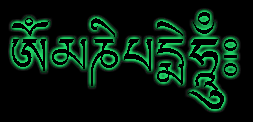
The City's history
Khara-hot was the oldest city in Gobi Desert, which situated on the east bank of Ezen (Lord in
Mongolian) River (the Chinese call Hei He, or Black River) and in
the middle of the Gobi Gurvansaikhan mountain (lowest part of the
Altai Mountains) and the Alasha Gobi (now in China).
The lost city
was a remote land in several hundred miles far from the Tumen
Gazruin Tsagaan Kherem (the White Wall of 10,000 li or just
Great Wall in correct English) in the north. The Great Wall chained
in the frontiers of Alasha Desert, which were the natural border of
Mongols and Chinese.
According to the Chinese resources, the city was the northern center
of Chinese civilization to distribute the Chinese culture to
Barbarians (our direct ancestors) since II century of B.C. The
Tangut's Shi-Shia Empire conquered this land in VIII century and
belonged to them for four centuries. But they lost in war with
Mongols and it was handed to the Mongol Empire in XII century.
Khara-hot
means the Black City in Mongolian language and it existed as a
Mongol city for centuries. In 1372 the Ming armies captured Ezen (Etsina)
region from the Mongols and destroyed the Khara-hot during the
Mongol-Chinese conflict.
In the Mongolian legend of Khara-hot, "the black & dead city", Khara
Baatar (black hero with black magic words) Janjin ruled this city
with his brave warriors.
The first legend of Khara Baatar and
the city's death
Khara Baatar was so great and powerful than the Chinese Emperor.
But
the Chinese armies encircled Khara-hot and Khara Baatar with his
people was without water, determined to die fighting at the head of
his brave warriors.
Khara Baatar prepared for the
attack, but his favorite daughter prevailed on him to save his life.
After a parley with Chinese Emperor it was decided that the Chinese
should be allowed to enter the town unopposed on the following
morning by the gate in the west wall.
During the night the whole Chinese army assembled before the western
gate impatiently awaiting the pillage of the coming day. But the
under cover of darkness of the night Khara Baatar and the remnant of
his army left the eastern gate of the town, and the his favorite
daughter stayed behind alone to open the western gate at daybreak in
fulfillment of the promise given.
The warriors, once so proudly mounted, were obliged to escape on
foot, for all their horses had died of thirst. Only at the head of
the melancholy remnant of his period army. All the while during the
flight the chief spoke "black words", and the country about the
fugitives was transformed. All natural life dead.
The trees of the
forest threw themselves to the ground, outstretched in the direction
in which Khara Baatar was disappearing and storms arose which soon
buried the country in sand.
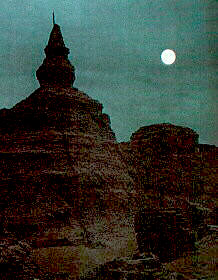
Night View of the
Kara-hot Wall
The Khara Baatar and his warriors went
never again on victorious campaigns, for they encamped upon the
boundary between their ancient land and that of the Chinese to let
themselves be buried under the advancing wave of sand.
But during the night, before the Chinese obtained entrance to the
town, Khara Baatar's daughter threw its remaining treasures into the
dried-up well. In the morning the Chinese found to their
consternation that what at sunset had been forests and fertile
grazing grounds was now transformed to barren desert.
Raging they
stormed into the town to seek vengeance and to plunder, but all they
found was one lonely girl who sat weeping in a watch tower.
Khara Baatar's treasure was never found by the Chinese, for the girl
was slain without having revealed its hiding place, and soldiers had
to flee hurriedly from the dead town and its barren surroundings if
they were nor to perish of thirst and hunger.
Since that time many treasure seekers have tried to bring to light
the assembled treasure of the town. On certain nights in may be
lying in a great pot deep down in the well, but so soon as anyone
approaches flames rise up for its protection. Shamans and Tibetan
lamas have been bought to frustrate the magic power that protects
it. But all has been vain.
The Khara Baatar's spirit still guards
the riches of the town.
The second legend of Khara Baatar and
the city's death
During the last days of Mongols rule Etsina was commanded by a brave
chief-man called Khara Baatar, a name given to him because of
his ability to invoke black magic.
On hearing that a large force of
rebellious Chinese was advancing against the city, he led his
warriors out to engage them in open country. But he was defeated and
had to withdraw within the wall of his fortress town.
The siege of city lasted a long time. Unable to take it by force,
the Chinese built a dam to cut off its source of water. This was a
channel of Black River that washed up against the wall as a sort of
moat whose bed could still be made out. The defenders dug a well in
the northwest corner of the city, desperately sinking it down over
nine hundred feet, but they failed to find any water.
Khara Baatar decided to go down fighting. He gave order to kill his
two wives and his son and daughter lest they be abused by the enemy.
And he hid all his treasures, over a million ounces of silver plus
untold quantities of gold and many other valuables, in the well
before filling it in.
Then, through of opening cut in the north wall, he galloped out at
the head of his men to fight his way through the gauntlet of
encircling Chinese. One by one his outnumbered warriors fell before
the pursuing Chinese. As he fled, fighting all the way, Khara Baatar
cried out words of black magic. Immediately, all life about him
withered and died.
Irrigated fields dried up, clops
shriveled, trees became skeletons, everything turned black, and sand
storms rose to cover the city and the countryside around it.
The discovery of Khara Baatar's
treasures
This dead human memory had slept for six centuries in the desert's
embrace when Peter Kuzimich Kozolov discovered it in 1909.
After a
month's work, during which the rapacious Russian traveler had to
maintain constant camel communications with the Ezen River, greedy
Kozolov found, deep beneath the sand, a vault filled with treasures
of art from long-vanished epoch, banners, marvelous paintings, cult
objects and quantities of ancient manuscripts.
The treasures he excavated had been
preserved undamaged through the centuries in the dry desert climate,
an the colors glowed with their pristine brilliance.
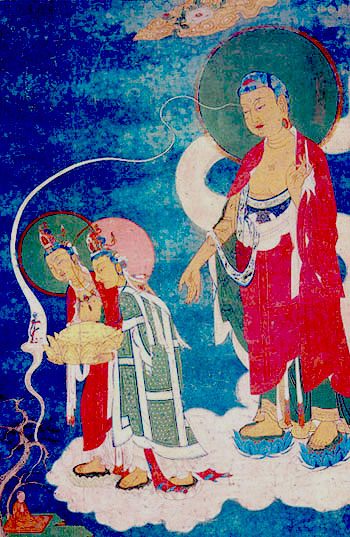
Hermitage Museum,
Sankt Petersburg, Russia
It was true and a real example of that
Mongols never were owners for own treasures.
Khara-Khorum & Erdene Zuu
The meaning of the word, Khara-Khorum, might be one of the following
words:
-
khara-khu'rem (black stone)
-
khara khorin (black wall)
-
khara-kerem (black castle)
-
khara-korum (black shivers of the ruins
of Uigur's KaraKorum, VIII CE)
-
khorin ger (twenty gers, according
to old Mongolian custom, was a center of the city)
-
kho'l khorin (a
place is not allowed to speak) and et cetera
The great ruler, Chingis khaan, ordered to build Khara-Khorum in
1220 as a capital of the Mongolian Empire. The second great khaan,
Ogodei, made it the real capital of the Mongolian Empire.
The fourth
great khaan, Monke, extended the city and Europian travelers
recorded the city in the world history in 1246 as "Khara Khorin".
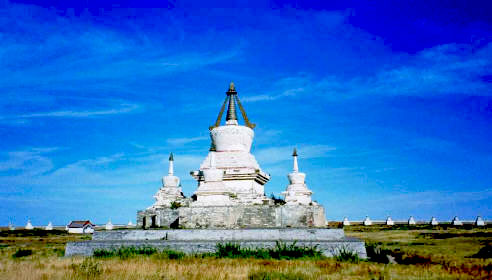
During the complicts between Arig-Bokhe and Khubilai khaan,
Khubilai's general Esunge slitely damaged Khara-Khorum and took over
in the winter, 1261.
In 1260, Khubilai khaan moved the Mongolian
capital from Khara-Khorum to Kaiping (Xanedu or Shandu in
Mongolian), then to Beejing (Daidu) in 1264. Later, Ming army
completely ruined Khara-Khorum in 1410.
Erdene Zuu monastery is the first Buddhist monastery in Mongolia. It
was built at the initiative of the most influential Khalha lord
Abtai Khan, in 1586 on the spot where Khara-Khorum, the famous
capital of the Mongolia Empire of the XIII century was.
The stone
columns, blocks and sculptures excavated from the ruins of the city
show that various building materials were used in the construction
of this monastery, which began in the XVI century and continued
until the XIX century.
|
Khara Kohrum
from
T'sMongoliaPage Website
.
Time is past...(surrounded
by barley fields)
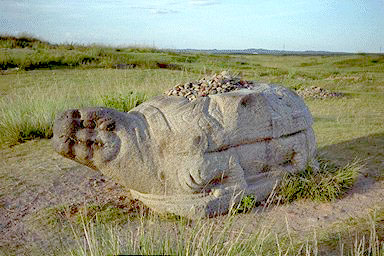
This is the tortoise
monument of Khara Kourum.
I heard that this stone had
been a foundation stone of the Palace. An small
textbook about Khara Kourum was sold at a stand in
Erdene zuu monastery. [Ancient Kara-Korum by Dr.L.Tudev]

The view of Erdene zuu
monastery from Khara Kourum. If you would like to be
able to walk Khara Kourum from Erdene zuu monastery.
The
white wall and Stupas are Erdene zuu's.
|
A considerable portion of the building
work of the temples, fortress and stupas was created under
the direction of the Mongolian artisan Manzshir and many Mongolian
craftsmen participated in erecting this architectural ensemble.
The
architectural style of the temples combines the style of ancient
Mongolian, Tibetan and Chinese architecture. Most noteworthy is that
not a single nail was used in the building.
The territory of the monastery occupies an area of 400 square meters
and is surrounded by a stone wall with 108 stupas. These stupas were
erected either in honor of a prominent historical event, or as the
grave of a state or religious figure. Almost ten thousand lamas
lived within the fortress, which contained more than 60 chapels of
various sizes.
Erdene Zuu is said to have had 108 Tsam dancers and
religious rites were arranged annually in different parts of the
monastery.
|
Erdene zuu monastery
(Now silent...)
from
T'sMongoliaPage Website
The golden stupa at Erdene
zuu.(named Zoborugun)
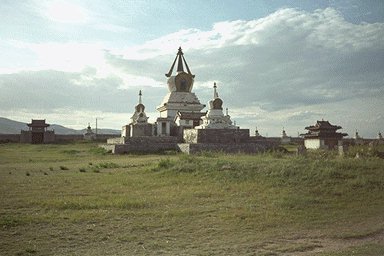
The gate of Erdene zuu
monastery.(near Lavrin zuu)
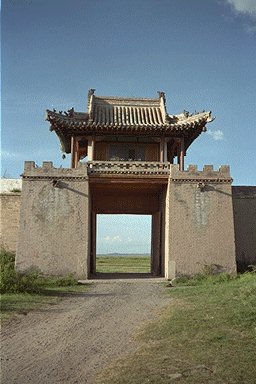
The stupa of Erdene zuu
monastery's wall.(There are 108th.) Erdene zuu monastery
is surrounded by this wall and stupas.
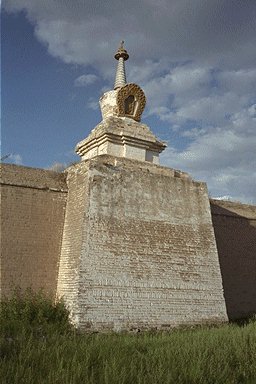
This is the Lavrin zuu.
(The wall of Erdene zuu monastery.) I felt long time
past and many things.( why am I here? what am I?)
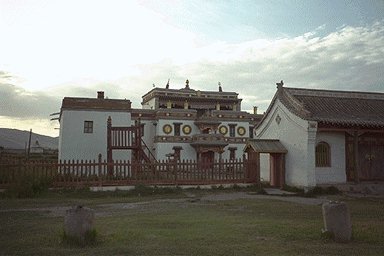 |
The Mongolians, Chinese, Arab and Tibetan scripts of the XIII and
XIV centuries have been preserved to the present in some of the
temples.
The chapel built in honor of the Tusheet Khan Chahundorj's
visit to Dalai Lama in 1675 is also situated here.
Furthermore there is a brick fortress wall with two graves, of Abtai
Khan who died in 1587, and his son Tusheet Khan Gombodorj. The tomb
of Gombodorj's wife is placed outside of the fortress in the so
called 'female sector' of the monastery, on the north eastern side.
Three main temples, "Three Zuu"
(below insert) the western temple of which was
built by Abtai Khan and his son Gombodorj, stand in most sacred
western side.
Three statues of 8 idols are placed in the temple, the
one on the left side depicting Sanjaa who, according to the
religious mythology, was the first disseminator of religion before
Buddha, the on of right being Jamba (the Holy Maitreya),
disseminator of Buddhism after Buddha, and the one in the centre is
Buddha in his old age.
|
Gurvan zuu
(Triple temples)
from
T'sMongoliaPage Website
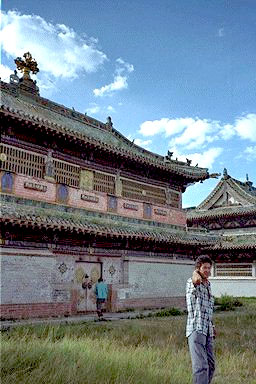
I could see the insight of
the Gurvan zuu.
When we reached the Gurvan zuu, it was
too late to see the insight. But Battutuushinn's father
did best negotiate for me.(Thanks a lot...)
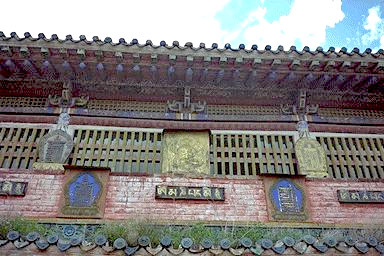
This temples's name were
written in real Mongolian letters.
Perhaps, we can't see
the real color of this temple's walls and windows from
this photograph, but they had been very colorful in the
past.
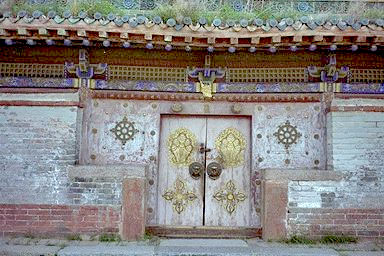
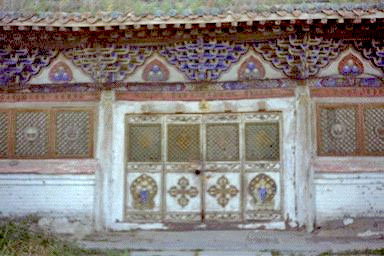
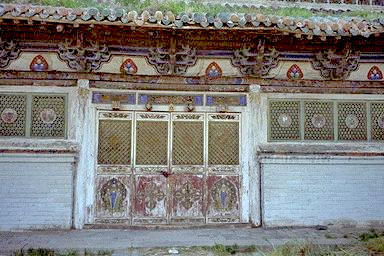
These are front entrance
of the triple temples. There were differences between
these doors. And I heard that there is important means
of number '3'. For example Past, modern and feature.
|
The main Central Zuu was built by the missionary Tsogt at the Zungen
Lord's ruling.
An idol can be seen on either side of the entrance of
the main shrine of Erdene Zuu, the idol Lham to the left and the
idol Gombogur to the right.
Three big idol statues are placed along the northern wall. On the
left of the God of medicine Otoch Manal, on the right is Holy Abida,
and the centre the Buddha in his youth. Statues of 8 idols are also
placed in the temple. These are the Buddha's disciples, the God of
the Moon, 8 Sages and others. A special pedestal displays dozens of
gilded statues of idols (chased and molded) the works of Under Gegen
Zanabazar, a master sculptor and artist.
The walls of the temple are adorned with
beautiful works of appliqué depicting the forest, mountains and
caves where the gods pursued their hermitic existence. These
pictures are called the land of the Thousand Buddha of Golden Time,
who have descended from heaven to earth.
The eastern temple of Zuu
was built by Erhi Mergen Khan's wife and the Bogdo Lama's mother.
There are three big statues displayed in the temple, on the left is
the Bogdo lama himself, on the right is the idol Janraiseg, and the
center is the image of the Buddha in his teenage years. The model of
the eastern Zuu temple made of brown sandalwood is placed on a
central pedestal.
The main stupa which is called the Golden Payer Stupa stands
in the northern sector. The three-circled palace of Lavran restored
in 1969-1973 is located nearby and is the only monument in Mongolia
of pure Tibetan style. The central square of the monastery, 45
meters in diameter, is paved with flagstones and is named the Square
of Happiness and Prosperity.
Legend says that the ger (yurta)
of Abtai Khan stood here, a big ger (yurta) or Benediction erected
in 1658, in which the annual assemblies of the Mongolian lords were
usually held. A grass-covered hollow has been left at the place near
the square where there was once a pond.
The Erdene Zuu monastery
preserves the marvelous works of the Mongolian artisans, painters,
cutters, sculptors, embroideries and craftsmen of the XVII century.
Erdene Zuu monastery was severely damaged at the end of the XVII
century and the beginning of the XVIII centuries at the time of the
struggle of the Mongolians against the Manchu invaders.
It was restored several times, in
1760-1796 and in 1808-1814.
|
















